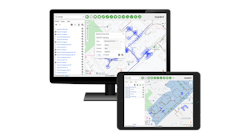Applying Data Center Architecture to the Access Network
As times and technology change, so must the way we approach how to provide the infrastructure needed to help our customers prepare and monetize their broadband networks. These broadband networks have become the central nervous system of today’s data-driven economy for both residential and business subscribers, and the number of people that leverage it continues to grow every day. According to a report from the International Telecommunications Union, the number of Internet users has grown from 738 million in 2000 to over 3 billion in 2015 alone.*
The network is at an inflection point that creates the opportunity for broadband service providers to move toward access networks that are open, programmable and scalable. Providing for the bandwidth demands of billions of people and connected devices requires a solution that goes beyond the standard hardware centric networks many operators rely on today. For this reason, service providers are looking for alternatives. Limited mobility, slow provisioning, and high OpEx and CapEx costs prove that the older networking environments are simply not equipped to handle the demands placed upon them in today’s world. Service providers understand the need to upgrade their networks, not only to meet the demands of today, but to create a stable foundation for future growth and service scalability.
The challenge is that while service providers want a more open, flexible network architecture, they also need to leverage assets they already have in place. Service providers need a solution that gives them end-to-end programmability, open APIs, and other vital functions that enable them to meet their revenue needs as well as customer needs. They need to minimize the time it takes to introduce a new service while eliminating any service disruption that may occur.
A good example of this is the process Facebook uses to issue releases on its platform multiple times a day with seamless integration for the user. For service providers with hardware centric networks, releases are done about every 18-24 months, and often require a hardware upgrade. To give their customers a customizable user-driven experience, service providers need to start moving toward an automated network with service orchestration.
AT&T quantifies the benefits of software defined access.
Another challenge service providers face is the growing Millennial population and the multi-dwelling unit (MDU) market. With nearly 35% of all homes in the US being MDUs, and 50% of those tenants in MDUs being Millennials, a new market sector is quickly being born that service providers must find a way to capitalize on.
MDUs account for nearly 80 million households and feature a wide variety of building/unit types and complex wiring variations. Service providers now need a solution that can handle the bandwidth and user-driven service demands Millennials require each day: from smartphone use to gaming systems.
Millennials have become the biggest demographic in the US, and being dubbed "The Renter Generation" means more and more Millennials will continue to move into MDUs — making this a key market opportunity to capture new subscribers and grow revenue.
Equipment providers are seeing these trends as well, and are working to help service providers face down these challenges and create a stable means for growth. One solution is a Software Defined Access (SD-Access) architecture that applies data center architecture principles to the broadband access network. Influenced by the scale and agility that data center networks have achieved, service providers are adopting those same architectural principles to transform their access networks. These principles include:
• Disaggregation of network elements and management systems to remove vertically integrated vendor silos in order to transition to open networking architectures.
• Virtualization through NFV principles to reduce the reliance on purpose-built hardware solutions, and increase the network agility through software-centric solutions.
• Network automation through SDN programming via open APIs reduces service provisioning times, errors, and IT complexity, while enabling customer self-service capabilities.
Operator test driving CORD Proof of Concept.
By adopting these key data center architectural principles, an open, programmable and scalable access network can be achieved. Developing solutions with the Central Office Re-architected as a Datacenter (CORD) project creates a path for open SDN control, virtualization of networking functions, a commitment to open networking principles and disaggregation of monolithic hardware and software systems. The accessibility and scalability of the data center can be applied to the broadband network, opening up new pathways for integration of access equipment directly into open source SDN controllers. This gives service providers a full suite of management apps built around the SDN controller.
Benefits to this network approach include better management capabilities to exploit cost benefits and ease-of-deployment, as well as horizontal scaling capabilities not seen in traditional deployments. The high cost of network overhead by minimizing vendor lock-in is eliminated through the use of open interfaces and open APIs for true SDN programmability. In a recent conference, AT&T cited the ability to manage 4 to 8 times more network traffic with the same amount of CapEx while being able to reduce OpEx costs by 40%-50% by implementing SDN and automation into its networks. The rapid creation of differentiated services is enabled by supporting micro-release schedules more aligned with service providers’ DevOps teams, reducing time-to-market delays. Additionally, consumer quality experience can be assured when utilizing data center switching and PON access architectures.
Virtualization, including NFV, is giving service providers the ability to drop virtual network functions onto an appliance without having to dispatch additional pieces of equipment or incur more costs. Ultimately, this transformation will encourage providers to focus on how to deliver capabilities such as 10G and OTT services to the customer.
SDN and NFV are providing real benefits by creating an open, programmable, and scalable broadband network supporting virtualized, Cloud-based residential, enterprise and mobile service delivery. Crafting the broadband access network around these end-to-end types of solutions, from the CORD-based central offices to the customer premises, gives service providers ultimate flexibility in choosing how and where they wish to deploy services in the future. Utilizing these data center architecture principles can leave service providers assured that their network can handle the demands of user-driven customers everywhere while having a foundation to grow on year over year.
Endnote
*For more information on the International Telecommunications Union report, please visit http://www.itu.int/net/pressoffice/press_releases/2015/17.aspx#.V-we6v4VCUk.







